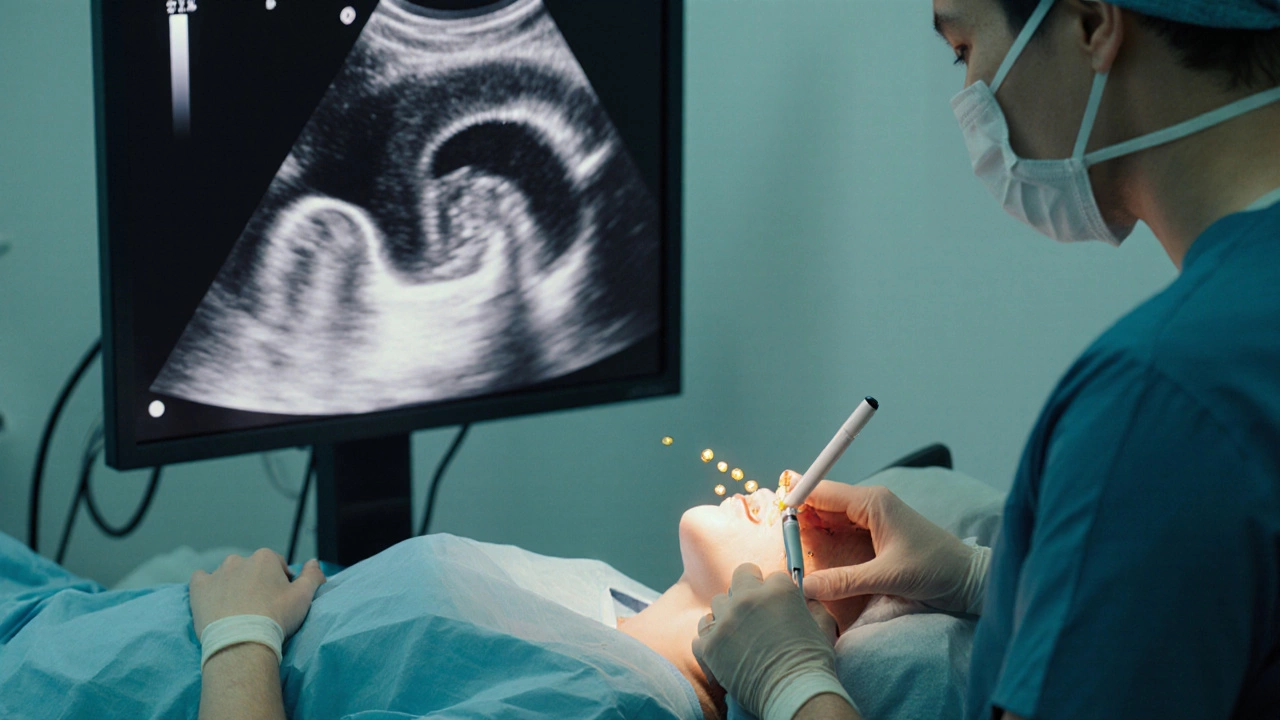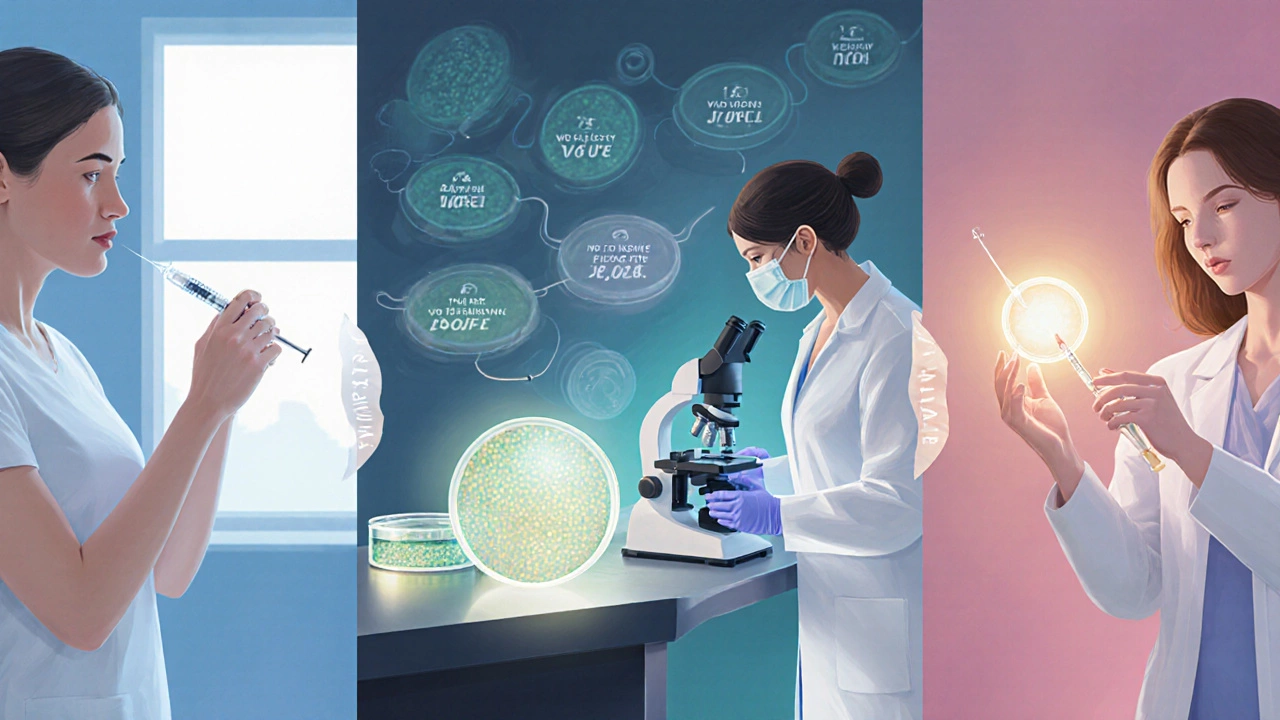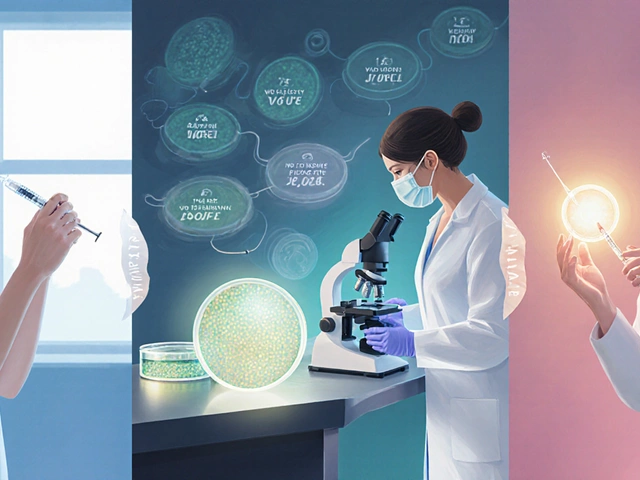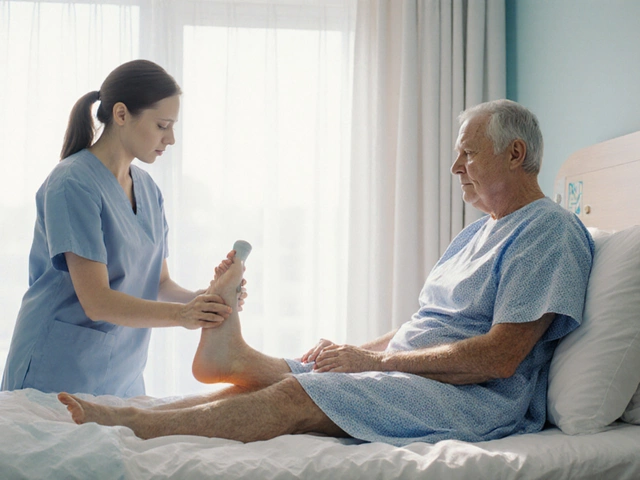IVF Timeline Calculator
How long until pregnancy?
Estimate your IVF timeline based on your age and protocol choice. Results are approximate and vary by clinic and individual factors.
Based on real-world data from the Society for Assisted Reproductive Technology (2024)
Key factors affecting your timeline: Age, ovarian reserve, protocol choice, and clinic logistics. Your timeline is based on typical data but may vary.
When you first hear about IVF is a set of lab‑based procedures that aim to unite an egg and sperm outside the body and then place the resulting embryo back into the uterus. The big question most couples ask is: “How long does it take to get pregnant?” The answer isn’t a single number-it depends on the protocol, your age, and how many cycles you need. Below we break down every phase, the typical calendar days, and the realistic odds so you can plan with confidence.
Quick Takeaways
- From the first hormone injection to a positive pregnancy test usually takes 4‑6 weeks.
- The embryo transfer itself happens about 5‑6 days after egg retrieval.
- Age, protocol choice (conventional, mini, or natural IVF) and clinic logistics are the biggest timing drivers.
- Most clinics schedule the next cycle 2‑4 weeks after a negative test, so a full treatment course can span several months.
- Understanding each step helps you set realistic expectations and reduces anxiety.
Step‑by‑step IVF Timeline
Your Fertility clinic specialized medical center that coordinates IVF cycles, lab work, and patient care. will guide you through each step. Below is the typical sequence for a conventional IVF cycle. Days are counted from the first day you start taking fertility‑boosting medication (“Day 1”).
- Ovarian Stimulation (Days 1‑10‑12) - Ovarian stimulation uses gonadotropins to develop multiple follicles. Daily injections continue until ultrasound shows the follicles are ready.
- Trigger Shot (Day 10‑12) - A short‑acting hormone (hCG or GnRH agonist) matures the eggs, preparing them for retrieval 34‑36 hours later.
- Egg Retrieval (Day 11‑13) - Performed under light sedation, a needle extracts the eggs from the ovaries.
- Fertilization & Embryo Culture (Days 13‑18) - Embryo transfer process where sperm meets the retrieved eggs in the lab, creating embryos that grow for 3‑5 days before transfer.
- Embryo Transfer (Day 16‑20) - The best‑quality embryo(s) are placed into the uterus using a thin catheter. Blastocyst culture growing embryos to Day 5‑6 before transfer, which can improve implantation rates.
- Luteal Phase Support (Days 20‑35) - Progesterone supplement keeps the uterine lining receptive.
- Pregnancy Test (≈Day 28‑35) - Pregnancy test blood test that measures β‑hCG levels to confirm implantation.
Putting it all together, the clock from the first injection to a definitive test result is roughly IVF timeline of 4‑5 weeks.
What Affects the Clock?
Even though the steps above look linear, several variables can stretch or compress the schedule.
- Age and Ovarian Reserve - Older patients often require a longer stimulation phase or higher medication doses, which can add a few days.
- Protocol Choice - GnRH antagonist protocol shorter cycle that blocks premature ovulation, typically shaving 2‑3 days off the timeline. Mini‑IVF and natural‑cycle IVF skip high‑dose drugs altogether, making the whole process 1‑2 weeks faster but usually with lower success per transfer.
- Lab Practices - Some labs culture embryos to the blastocyst stage (Day 5‑6) before transfer. This adds a day or two but may improve implantation.
- Clinic Scheduling - Busy clinics may batch retrievals on specific days of the week, causing a short wait before the next available slot.
- Response Monitoring - Frequent ultrasounds and hormone checks can slightly shift the trigger day.

Average Time to Pregnancy: Numbers from Real‑World Data
Large registries (e.g., Society for Assisted Reproductive Technology, 2024) report the following median times:
| Protocol | Average Days (Start → Positive Test) | Typical Success Rate (per transfer) |
|---|---|---|
| Conventional IVF (fresh transfer) | 28‑35 | 35‑45 % |
| GnRH antagonist (short protocol) | 24‑30 | 33‑42 % |
| Mini‑IVF (low‑dose) | 21‑28 | 20‑30 % |
| Natural‑cycle IVF | 18‑24 | 12‑18 % |
These figures show that a “positive pregnancy test” typically appears within five weeks of the first medication dose, but the overall journey to a live birth can span several months because many couples need more than one cycle.
Real‑World Timeline Scenarios
Let’s walk through three common patient profiles.
Scenario 1: 30‑year‑old, good ovarian reserve, using conventional IVF
- Day 1: Start gonadotropins
- Day 11: Trigger, retrieval on Day 12
- Day 16: Fresh embryo transfer
- Day 30: Blood pregnancy test - positive 70 % of the time
- Total: 4 weeks from first injection to confirmation.
Scenario 2: 38‑year‑old, low reserve, opting for GnRH antagonist
- Day 1: Start lower‑dose gonadotropins + antagonist
- Day 9: Trigger, retrieval on Day 10
- Day 14: Blastocyst transfer (Day 5 embryo)
- Day 28: Pregnancy test - positive ~30 % of cycles
- Total: About 4 weeks, but often followed by a second cycle.
Scenario 3: 33‑year‑old, prefers a gentler approach, chooses mini‑IVF
- Day 1: Very low dose oral meds, monitoring starts
- Day 8: Trigger, retrieval on Day 9
- Day 13: Fresh transfer (Day 4 embryo)
- Day 27: Pregnancy test - positive ~22 % of cycles
- Total: Roughly 3½ weeks, but many need 2‑3 cycles for success.

Tips to Keep the Process on Track
- Plan Ahead - Schedule your first medication cycle when you can take a few days off work; this prevents rushed appointments.
- Stay on Top of Monitoring - Promptly attend ultrasound and blood‑work visits; delays often stem from missed appointments.
- Ask About “Batch” Retrievals - Some clinics group cycles on specific weekdays; knowing the schedule early helps you align personal commitments.
- Consider Short‑Protocol Options - If you’re eager to shorten the timeline and meet criteria, discuss GnRH antagonist or mild stimulation with your doctor.
- Maintain Wellness - Adequate sleep, balanced diet, and stress‑reduction can improve ovarian response, potentially reducing the need for extra cycles.
Frequently Asked Questions
When exactly can I take a pregnancy test after embryo transfer?
Most clinics recommend a serum β‑hCG test 12‑14 days after the transfer, which corresponds to about Day 28‑35 from the start of stimulation. A home urine test can be done a few days later, but the blood test is more reliable.
Can I start a new IVF cycle immediately after a negative test?
Usually you wait 2‑4 weeks for hormone levels to normalize. Some clinics may offer “back‑to‑back” cycles for younger patients with good response, but most recommend a short recovery period.
Does a faster protocol mean lower success?
Not always. Short‑protocol (GnRH antagonist) cycles have comparable success to long protocols in many age groups. However, natural‑cycle IVF, while quicker, generally yields lower pregnancy rates per transfer.
How many cycles should I expect before achieving pregnancy?
Statistically, about 60‑70 % of women under 35 achieve a live birth within three cycles. Success drops with age, so older patients may need more attempts or consider adjuncts like pre‑implantation genetic testing.
Is it safe to fast‑track a cycle by skipping monitoring?
Skipping ultrasounds or hormone checks can lead to missed ovulation or ovarian hyper‑stimulation, which may jeopardize both safety and success. Proper monitoring is a non‑negotiable part of the timeline.
Bottom Line
The short answer to “How long does IVF take to get pregnant?” is roughly four to six weeks from the first injection to a confirmed pregnancy test, but the broader journey can extend over several months if more than one cycle is required. Knowing each step, the factors that stretch the schedule, and realistic success odds empowers you to plan financially, emotionally, and logistically.






